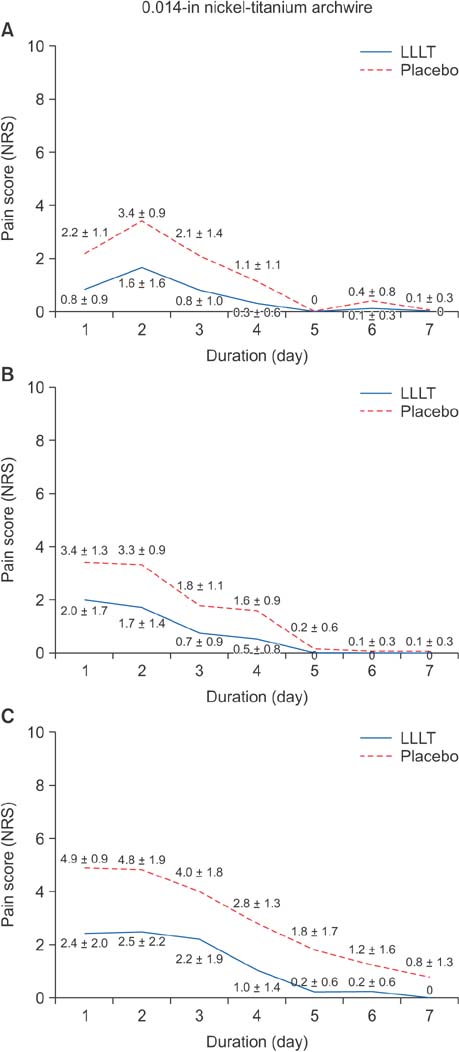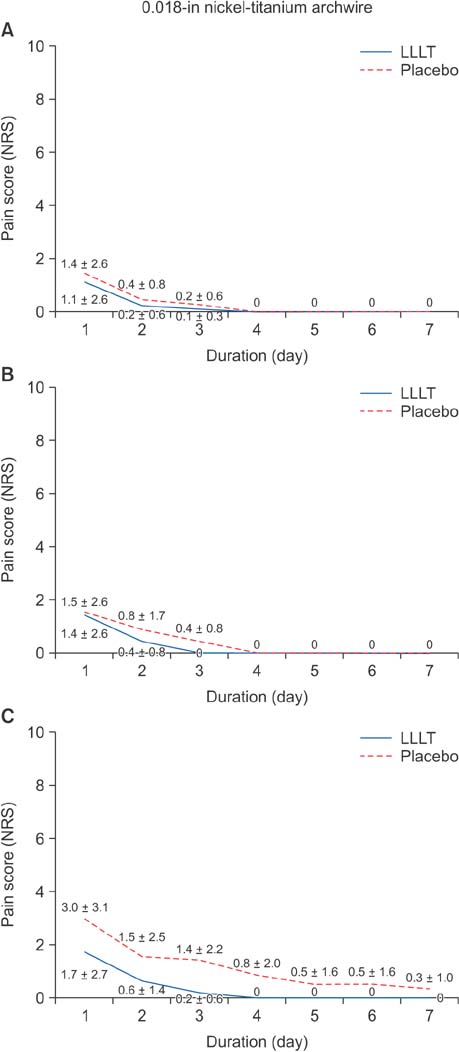Korean J Orthod.
2018 Mar;48(2):90-97. 10.4041/kjod.2018.48.2.90.
Effects of single-dose, low-level laser therapy on pain associated with the initial stage of fixed orthodontic treatment: A randomized clinical trial
- Affiliations
-
- 1Department of Orthodontics, Baqai Dental College, Baqai Medical University, Karachi, Pakistan. drirfan_andani@yahoo.com
- 2Orthodontic Department, College of Dentistry, Aljouf University, Sakaka, Saudi Arabia. dralam@gmail.com
- 3Department of Orthodontics, Liaquat College of Medicine and Dentistry, Karachi, Pakistan.
- KMID: 2406817
- DOI: http://doi.org/10.4041/kjod.2018.48.2.90
Abstract
OBJECTIVE
The aim of this study was to assess the analgesic effect of a single application of low-level laser therapy (LLLT) on spontaneous pain and pain on chewing after placement of initial archwires.
METHODS
Forty-two patients (26 women, 16 men) were randomly recruited for this split-mouth randomized clinical trial. Each patient received super-elastic nickel-titanium (NiTi) initial archwires (0.012, 0.014, 0.016, and 0.018-inch [in]) in the maxilla for leveling and alignment for an interval of 4 weeks between archwires. One side of the mouth was randomly designated as experimental, while the other side served as placebo. After insertion of each archwire, the experimental side was irradiated with a diode laser for 3 seconds each on 5 points facially and palatally per tooth, from the central incisor to first molar. On the placebo side, the laser device was held the same way but without laser application. A numerical rating scale was used to assess the intensity of spontaneous and masticatory pain for the following 7 days. The Mann-Whitney U test was used to compare pain scores between sides.
RESULTS
Patients in the LLLT group exhibited significantly lower mean scores for spontaneous pain after insertion of the initial two archwires (0.012-in and 0.014-in NiTi; p < 0.05), while there was no significant difference for 0.016-in and 0.018-in wires between the LLLT and placebo groups. LLLT significantly reduced chewing pain scores (p < 0.05) for all archwires.
CONCLUSIONS
A single dose of LLLT considerably lessened postoperative pain accompanying the placement of super-elastic NiTi wires for initial alignment and leveling.
MeSH Terms
Figure
Reference
-
1. Krishnan V. Orthodontic pain: from causes to management--a review. Eur J Orthod. 2007; 29:170–179.
Article2. Sergl HG, Klages U, Zentner A. Pain and discomfort during orthodontic treatment: causative factors and effects on compliance. Am J Orthod Dentofacial Orthop. 1998; 114:684–691.
Article3. Turhani D, Scheriau M, Kapral D, Benesch T, Jonke E, Bantleon HP. Pain relief by single low-level laser irradiation in orthodontic patients undergoing fixed appliance therapy. Am J Orthod Dentofacial Orthop. 2006; 130:371–377.
Article4. Koritsánszky N, Madléna M. Pain and discomfort in orthodontic treatments. Literature review. Fogorv Sz. 2011; 104:117–121.5. Jones M, Chan C. The pain and discomfort experienced during orthodontic treatment: a randomized controlled clinical trial of two initial aligning arch wires. Am J Orthod Dentofacial Orthop. 1992; 102:373–381.
Article6. Krukemeyer AM, Arruda AO, Inglehart MR. Pain and orthodontic treatment. Angle Orthod. 2009; 79:1175–1181.
Article7. Polat O, Karaman AI. Pain control during fixed orthodontic appliance therapy. Angle Orthod. 2005; 75:214–219.8. Ngan P, Wilson S, Shanfeld J, Amini H. The effect of ibuprofen on the level of discomfort inpatients undergoing orthodontic treatment. Am J Orthod Dentofacial Orthop. 1994; 106:88–95.
Article9. Kyrkanides S, O'Banion MK, Subtelny JD. Nonsteroidal anti-inflammatory drugs in orthodontic tooth movement: metalloproteinase activity and collagen synthesis by endothelial cells. Am J Orthod Dentofacial Orthop. 2000; 118:203–209.
Article10. Tyrovola JB, Spyropoulos MN. Effects of drugs and systemic factors on orthodontic treatment. Quintessence Int. 2001; 32:365–371.11. Walker JB, Buring SM. NSAID impairment of orthodontic tooth movement. Ann Pharmacother. 2001; 35:113–115.
Article12. Arias OR, Marquez-Orozco MC. Aspirin, acetaminophen, and ibuprofen: their effects on orthodontic tooth movement. Am J Orthod Dentofacial Orthop. 2006; 130:364–370.
Article13. Shenoy N, Shetty S, Ahmed J, Shenoy KA. The pain management in orthodontics. J Clin Diagn Res. 2013; 7:1258–1260.
Article14. Hwang JY, Tee CH, Huang AT, Taft L. Effectiveness of thera-bite wafers in reducing pain. J Clin Orthod. 1994; 28:291–292.15. Roth PM, Thrash WJ. Effect of transcutaneous electrical nerve stimulation for controlling pain associated with orthodontic tooth movement. Am J Orthod Dentofacial Orthop. 1986; 90:132–138.
Article16. Weiss DD, Carver DM. Transcutaneous electrical neural stimulation for pain control. J Clin Orthod. 1994; 28:670–671.17. Marie SS, Powers M, Sheridan JJ. Vibratory stimulation as a method of reducing pain after orthodontic appliance adjustment. J Clin Orthod. 2003; 37:205–208. quiz 203-4.18. Cruz DR, Kohara EK, Ribeiro MS, Wetter NU. Effects of low-intensity laser therapy on the orthodontic movement velocity of human teeth: a preliminary study. Lasers Surg Med. 2004; 35:117–120.
Article19. Lim HM, Lew KK, Tay DK. A clinical investigation of the efficacy of low level laser therapy in reducing orthodontic postadjustment pain. Am J Orthod Dentofacial Orthop. 1995; 108:614–622.
Article20. Tortamano A, Lenzi DC, Haddad AC, Bottino MC, Dominguez GC, Vigorito JW. Low-level laser therapy for pain caused by placement of the first orthodontic archwire: a randomized clinical trial. Am J Orthod Dentofacial Orthop. 2009; 136:662–667.
Article21. Kim WT, Bayome M, Park JB, Park JH, Baek SH, Kook YA. Effect of frequent laser irradiation on orthodontic pain. A single-blind randomized clinical trial. Angle Orthod. 2013; 83:611–616.22. Angelieri F, Sousa MVS, Kanashiro LK, Siqueira DF, Maltagliati LÁ. Effects of low intensity laser on pain sensitivity during orthodontic movement. Dental Press J Orthod. 2011; 16:95–102.23. Mizutani K, Musya Y, Wakae K, Kobayashi T, Tobe M, Taira K, et al. A clinical study on serum prostaglandin E2 with low-level laser therapy. Photomed Laser Surg. 2004; 22:537–539.
Article24. Eslamian L, Borzabadi-Farahani A, Hassanzadeh-Azhiri A, Badiee MR, Fekrazad R. The effect of 810-nm low-level laser therapy on pain caused by orthodontic elastomeric separators. Lasers Med Sci. 2014; 29:559–564.
Article25. Schulz KF, Chalmers I, Grimes DA, Altman DG. Assessing the quality of randomization from reports of controlled trials published in obstetrics and gynecology journals. JAMA. 1994; 272:125–128.
Article26. Ngan P, Kess B, Wilson S. Perception of discomfort by patients undergoing orthodontic treatment. Am J Orthod Dentofacial Orthop. 1989; 96:47–53.
Article27. Kavaliauskiene A, Smailiene D, Buskiene I, Keriene D. Pain and discomfort perception among patients undergoing orthodontic treatment: results from one month follow-up study. Stomatologija. 2012; 14:118–125.28. Pandis N, Walsh T, Polychronopoulou A, Katsaros C, Eliades T. Split-mouth designs in orthodontics: an overview with applications to orthodontic clinical trials. Eur J Orthod. 2013; 35:783–789.
Article29. Antczak-Bouckoms AA, Tulloch JF, Berkey CS. Split-mouth and cross-over designs in dental research. J Clin Periodontol. 1990; 17:446–453.
Article30. Nóbrega C, da Silva EM, de Macedo CR. Low-level laser therapy for treatment of pain associated with orthodontic elastomeric separator placement: a placebo-controlled randomized double-blind clinical trial. Photomed Laser Surg. 2013; 31:10–16.
Article31. Katoh H. Effect of far-infrared rays radiation on pain reaction associated with orthodontic tooth movement. J Jpn Orthod Soc. 1997; 56:17–25.32. Jawad MM, Husein A, Alam MK, Hassan R, Shaari R. Overview of non-invasive factors (low level laser and low intensity pulsed ultrasound) accelerating tooth movement during orthodontic treatment. Lasers Med Sci. 2014; 29:367–372.
Article33. Holdgate A, Asha S, Craig J, Thompson J. Comparison of a verbal numeric rating scale with the visual analogue scale for the measurement of acute pain. Emerg Med (Fremantle). 2003; 15:441–446.
Article34. Jensen MP, Karoly P, Braver S. The measurement of clinical pain intensity: a comparison of six methods. Pain. 1986; 27:117–126.
Article35. Domínguez A, Velásquez SA. Effect of low-level laser therapy on pain following activation of orthodontic final archwires: a randomized controlled clinical trial. Photomed Laser Surg. 2013; 31:36–40.
Article36. Furstman L, Bernick S. Clinical considerations of the periodontium. Am J Orthod. 1972; 61:138–155.
Article37. Jones ML, Richmond S. Initial tooth movement: force application and pain--a relationship? Am J Orthod. 1985; 88:111–116.
Article38. Jian F, Lai W, Furness S, McIntyre GT, Millett DT, Hickman J, et al. Initial arch wires for tooth alignment during orthodontic treatment with fixed appliances. Cochrane Database Syst Rev. 2013; (4):CD007859.
Article
- Full Text Links
- Actions
-
Cited
- CITED
-
- Close
- Share
- Similar articles
-
- Effectiveness of low-level laser therapy and chewing gum in reducing orthodontic pain: A randomized controlled trial
- Efficacy of High Intensity Laser Therapy in the Mild Osteoarthritis of the Knee: A Randomized Double-blind Controlled Trial
- The effect of low-level laser therapy on external anal sphincter repair and treatment of fecal incontinence: A double-blind randomized controlled clinical trial
- Effects of Low Level Laser Therapy on Herpetic Neuralgia
- Clinical Application of Low-reactive Level Laser Therapy and Polarized Light Therapy for Chronic Pain Syndrome





